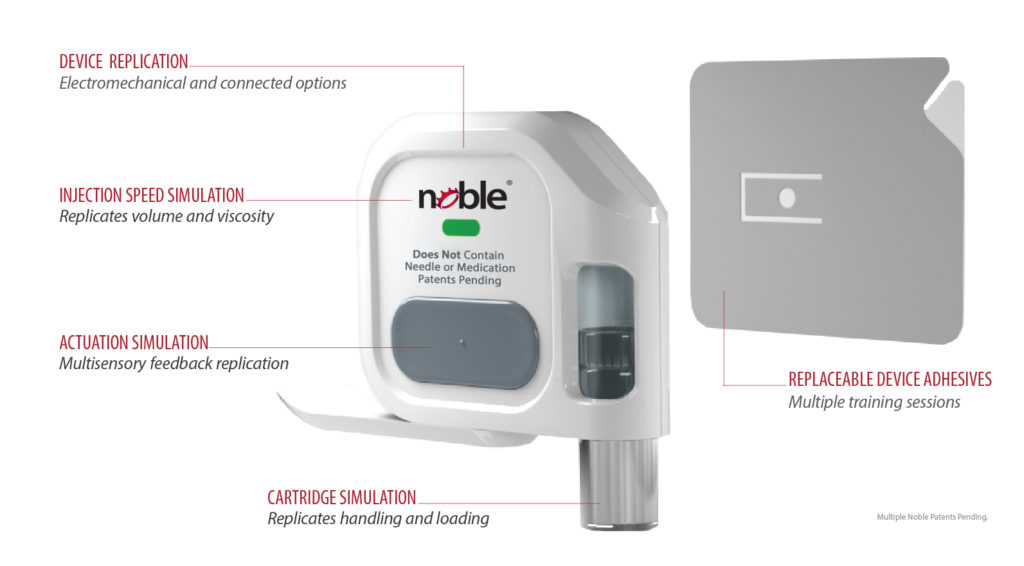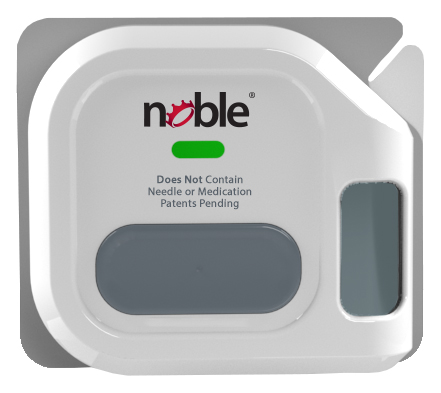Citation: Reynolds J, “Training Patients in the Use of Wearable Injectors”. ONdrugDelivery Magazine, Issue 100 (Sep 2019), pp 78-80.
Joe Reynolds highlights the projected growth in popularity of wearable injector devices, and shows that it is imperative for healthcare providers (HCPs) both to train their patients properly in the office, and offer training devices that patients can take home and practice with.
Millions of patients worldwide living with rare, debilitating conditions are benefiting from developments in biopharmaceuticals and complex chemical entities as well as novel approaches to drug delivery. For example, many therapeutics administered in a subcutaneous injection are suitable for at-home administration by patients themselves, rather than in a healthcare facility.
More recently, electromechanical on-body injector devices that provide extended dosing – such as those that can provide delivery over 45 minutes at specific time intervals – are making it possible for patients to undergo longer injections while at home or even out and about. These devices allow patients with chronic conditions to administer medications at home in private, while also providing an advanced, timed-dose alternative to daily prefilled syringe injections, autoinjector injections and infusions. As a result, there has been a steady rise in the popularity of these devices and the overall wearable devices market is expected to continue to drive approximately US$32 billion (£26 billion) in global revenue this year.
To address the demand for this emerging market, Noble has developed on-body training solutions and platform technologies that can be used by manufacturers to meet specific onboarding needs. Designing optimal training devices comes down to the unique needs of patients and other user populations. This is why Noble’s development process and proprietary portfolio of multisensory, error-detecting, wireless and smart technologies support manufacturers in prioritising requirements and developing solutions that maximise training value for patients and other stakeholders.
HOW THE TRAINERS WORK
A typical on-body self-injection system is affixed via adhesive onto a patient’s body (typically the abdomen or the back of the arm), either by the HCP or by patients themselves. For instance, following the administration of chemotherapy, an on-body device will be attached to the patient’s body to ensure delivery of a dose of medicine the next day in the form of a subcutaneous injection.
During the interval between the device being attached to the body and the actual time of dosing, the system will signal to the patient via feedback, such as sounds or lights, that it is operating properly. As the time of dosing approaches, the device will indicate that dosing is about to begin. Additional feedback may also show that dosing is currently underway. A window built into the device may display that dosing has been completed satisfactorily.
Key Features
Many of these helpful auditory and visual modes of feedback are known as “smart” features, and just like the true device,Noble’s trainers incorporate many of these to foster a more robust and accurate training experience (Figure 1). Some smart features include the design form and the LED signals that provide crucial operational information to users, as well as the small window on the side of the device that indicates whether the entire dose has been delivered. Further, the Noble trainer effectively mimics the tactile feedback and actuation force that is featured by such a platform. These are designed to work in tandem with smartphone apps and can provide real-time feedback to the patient regarding any errors associated with the use of the device as they occur. This information can also allow drug manufacturers to learn how well their devices are being utilised by patients.

Figure 1: Noble on-body training devices replicate the form and function of specific on-body devices to help patients onboard easier.
In addition to smart features, the trainers are also capable of injection speed simulation, which mirrors a variety of customisable drug delivery times and replicates the volume and viscosity of the drug as it is delivered to the patient. Meanwhile, actuation simulation is made possible by components developed to simulate visual, auditory and haptic feedback through LED light signals, sounds and clicks, as well as actuation button resistance.
Furthermore, the trainers are designed to allow cartridge simulation, providing patients with a realistic device-loading experience prior to the injection part of the training. Noble’s trainers also include a number of replaceable device adhesives, which allow patients to train multiple times and to gain familiarity with device initiation pull tabs, adhesive backings and the proper placement of the device on the body.
BENEFITS PROVIDED BY USING THE TRAINERS
Comfort
Collectively, the trainers’ features enhance user experience in numerous ways, including setting patient expectations of the comfort level associated with the device. Typically, on-body self-injection devices require needle insertion for an extended period while affixed to the body. Using a training device can be an effective way to convey to the patient that there may be less discomfort than anticipated while using the actual device. Trainers can also assure patients that the protection features built into on-body injection devices can prevent needlestick injuries when used correctly.
Correct Usage
As with all therapies involving drug delivery devices used outside a healthcare setting, the course of treatment cannot achieve expected efficacy if the patient does not use the device correctly. Misuse may result in a less-than-complete dose, or other consequences that lead to suboptimal health outcomes. Studies indicate that improved outcomes may be achieved with the use of training devices for injection-based delivery systems. Such trainers allow patients to practise wearing an on-body device and experience its operation before actually going through dosing with the prescribed therapeutic. The goals are to help patients feel comfortable in advance of using the on-body device, reduce any undue anxiety and ensure that they will utilise the device correctly.
Adherence and Confidence
It is also vital to ensure that patients are truly comfortable with their on-body device and can oversee its operation on their own. Studies have suggested that more comprehensive educational strategies surrounding the use of injection devices is required to improve the patient experience and to encourage adherence. Although HCPs have traditionally instructed patients to read the Instructions for Use (IFU) that come with a device, this measure alone is often not effective in boosting adherence and overall confidence using the device.

Figure 2: On-body trainers allow patients to become familiar with the operation process before using the true device.
In fact, a study conducted by Noble and analysed by Auburn University (AL, US) found that more than 60% of patients self-reported that they did not thoroughly read the required steps outlined in a self-injection’s IFU prior to beginning treatment, potentially leading to administration errors and impacting compliance with prescribed therapies. Similar outcomes can occur with on-body injection devices as well, and advanced training devices that better prepare patients for the true injection may help reduce these errors while simultaneously increasing patient confidence.
Fostering overall patient confidence is vital, which is why – for on-body devices in particular – trainers are an important tool to help patients understand how the device may be concealed by clothing when in use. This can alleviate apprehension about stigmatisation resulting from the use of the device that they may initially believe would be noticeable (Figure 2).
ADVANCED DESIGN FEATURES
Adhesion
From a user-experience standpoint, one of the most distinguishable differences between on-body systems and conventional injectors is that they are held in place on a patient’s body using adhesives. Incorporating this into reusable training devices requires careful consideration for sanitation, biocompatibility and other design trade-offs. To assist manufacturers through the process, Noble has developed proprietary adhesive and alternative simulation methods that balance these trade-offs and optimise training. This is done so that patients can realistically learn how to adhere and remove devices from their body and understand how long it takes the medication to deploy and be fully delivered.
Forces
In addition to addressing device adhesion, all functions requiring force application by the user must accurately represent the real device. Force profiles can also play a significant role; some forces may ramp up slowly, while others have a fast onset for activation. Within the on-body market, there are also devices that have unique steps for loading, priming, unlocking and other functional features that need to be replicated by a trainer.
Sensory
Other considerations include representing the audible and haptic feedback levels that are present and integrating tactile feel elements, such as subtle internal vibrations associated with drive elements. In addition to these items, the training device must be easily resettable (versus just a single-use product) and must also maintain a 1:1 size ratio (i.e. it cannot get any larger than the real drug delivery device).
BENEFITS FOR HCPS & PHARMA MANUFACTURERS
Patients are not the only group that reap benefits from training devices. When patients are better trained and more informed, they are statistically more likely to adhere to their therapies, which is a boon for HCPs, pharmaceutical companies and manufacturers. Annually, pharmaceutical revenue loss is $637 billion due to non-adherence. One way to help mitigate this staggering loss is through empowering patients to stay involved with their therapies through repeated use of training devices and other advanced training solutions.
It is in HCPs’ best interest to ensure that on-body devices are used properly and deliver the optimal dose of drug to their patients. By augmenting traditional patient onboarding methodologies, trainers can help facilitate this goal.
Meanwhile, on-body trainers can enhance a pharmaceutical manufacturer’s standing within the rapidly expanding on-body drug delivery market. Debuting a new on-body device in tandem with a trainer can allow the company to distinguish itself from competitors and build a positive reputation among potential patients. Additionally, utilising training devices in clinical trials can help solidify their importance in a strong patient training programme.
SUMMARY
Noble aims to improve the patient experience, reduce errors and anxiety and help increase adherence to prescribed injectable therapies by offering advanced technologies and education materials informed by human factors analysis. It has also developed a portfolio of support materials – such as IFUs, instructional videos and more – to bolster the patient onboarding experience further.
As an increasing number of innovative on-body therapies continue to reach the market, onboarding and training can help to improve patient acceptance, confidence, satisfaction and outcomes with therapy.
BiBLIOGRAPHY
- Evans C, “Device training: Maximizing patient adherence by minimizing the forgetting curve”. Drug Development & Delivery, 2018, Vol 18(1), pp 22-25.
- McLean T, “West’s SmartDose platform: a wearable engineered with both patient & pharma partner in mind”. ONdrugDelivery, Issue 70 (September 2016), pp24-27.
- “On-body training and onboarding platforms”. Company Web Page, Noble, August 2019.
- “Pharmaceutical & healthcare leaders collaborate to improve the patient journey”. Press Release, Noble, October 17, 2016.
- “Pharmaceutical Companies Lose $637 Billion in Revenue Annually Due to Medication Nonadherence.” Press Release, HealthPrize Technologies, April 26, 2019.
- Salazar D, “From ‘wearables to ther-ables.’” Drug Store News, April 14, 2016.
- “West and Noble collaborate to improve patient education and training for self-injection systems”. Press Release, West Pharmaceutical Services, January 20, 2016.
Previous article
PRIMARY PACKAGING FOR WEARABLE INJECTION DEVICESNext article
THE CHANGING DRUG DELIVERY PARADIGM
